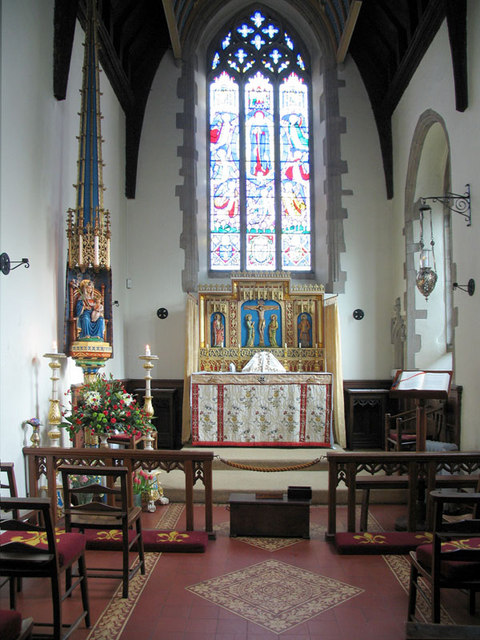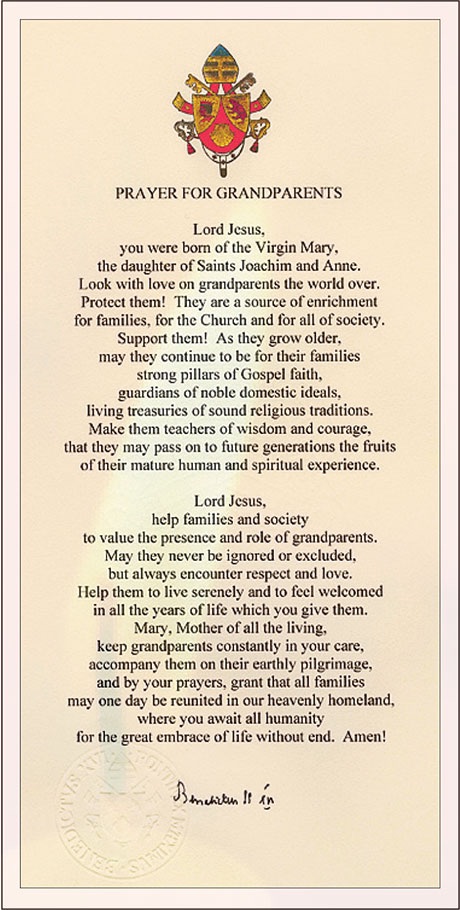On a Mission for Catholic Grandparents
Founder of an association dedicated to the vocation of families’ elderly says their role is encouraging the ‘story of the living faith.’

Catherine Wiley remembers her paternal grandfather fondly, recalling being “very close to him, my closest relationship as a child.”
Her most poignant memory of her grandfather is of him leading the family Rosary. Each night she would watch as, kneeling and deep in prayer, he would slip the beads through his fingers, his face illuminated by the flickering light from the fire.
Today, many years later, as she recalls the memory of his witness, it brings tears to her eyes.
“He died when I was 5 years old,” says Wiley, but “I [still] get tremendous strength from my grandfather’s faith.”
Part of that strength has sustained Wiley on her current mission, which began on Sept. 8, 2000, while praying in front of a statue of Our Lady of Walsingham at that Marian shrine’s Slipper Chapel.

“It was Our Lady’s birthday. I wanted to give her a birthday present. But what could I give the Mother of God? I had just become a grandparent. An inspiration came: to have a pilgrimage in honor of Sts. Joachim and Anne. It would delight Our Lady and honor and thank all our grandparents,” Wiley told the Register this Aug. 9.
So began her mission.
Wiley is a successful businesswoman, used to getting things done, so perhaps it is not surprising that the first such pilgrimage took place at Walsingham Shrine soon after, in 2002. Two years later, in her native Mayo, Ireland, Wiley organized a grandparents’ pilgrimage to the Marian shrine of Knock. Approximately 5,000 people attended that event. The next year’s Irish pilgrimage, again at Knock, attracted 10,000 grandparents. From then on, Wiley said, “The grandparents’ pilgrimages became the foundation stone” of what would later become the Catholic Grandparents Association (CGA).
Given that the inspiration for the CGA was received at Walsingham, an important place of pilgrimage going back to the Middle Ages, it is hardly surprising that Wiley sees “pilgrimage” as central to what the CGA is and does. “When you have 10,000 grandparents collected in one place on pilgrimage, you feel the faith and the power of their faith — it is inestimable. You feel it, breathe it and are part of it. It is the faith in living form.”
Faith and Fellowship
For Wiley, it is from these pilgrimages that Catholic grandparents find the strength and inspiration to tackle the myriad difficulties of modern life. “The CGA helps grandparents explore issues like how to pass on the faith when there’s divorce in the family, or when grandparents are separated from their grandchildren, or what to do if grandchildren are not baptized, or if children have fallen away from the faith,” she said. And she feels that such situations are the moments when “the Catholic grandparent stands out: bringing Christ’s mercy.”
Wiley senses her chief role currently is to awaken Catholic grandparents to their vocation and the practical and spiritual ministry that flows from it. Once the vocation is recognized, the CGA is there to support and strengthen it. Wiley is quick to point out that grandparents anywhere can start a branch of the CGA: “Go on the website and contact us.” She is clear about one thing that Catholic grandparents must not do, however, and that is nothing: “Whatever you do when you have the inspiration [about your vocation], do something!”
Wiley describes the association as akin to “being part of one big family,” one with shared intent. Normally members of branches meet once a month. Wiley feels that it is important that these meetings are held in conjunction with one’s local parish. At CGA meetings, there is prayer, followed by introductions and a time for sharing. “Sometimes people will have special intentions to pray for,” said Wiley. “Then they might discuss a topic — for example, how to organize a grandparents’ day in school.” Although Wiley says such meetings offer “a structured support group for grandparents,” she is adamant that “the essential part” of the CGA remains prayer. “I have learned prayer is all-powerful,” said Wiley.
Papal Prayer and Worldwide Growth
In 2006 Wiley’s sense of mission prompted her to write to Pope Benedict XVI. She asked the Holy Father to write a prayer specifically for grandparents. Pope Benedict wrote the prayer — perhaps the first pontifical prayer of its kind in the history of the Church.
“Lord Jesus, you were born of the Virgin Mary, the daughter of Sts. Joachim and Anne. Look with love on grandparents the world over. Protect them! They are a source of enrichment for families, for the Church and for all of society. Support them! As they grow older, may they continue to be for their families strong pillars of Gospel faith, guardians of noble domestic ideals, living treasuries of sound religious traditions. Make them teachers of wisdom and courage, that they may pass on to future generations the fruits of their mature human and spiritual experience.”

Wiley feels that “the spiritual significance of grandparents must have been a powerful stimulus for Pope Benedict [causing him to] write such an incredibly long and beautiful prayer.” For Wiley, the prayerful words of the pope emeritus became for her “the golden key” to her growing sense of mission. Reading the prayer she realized it was “the greatest tool for evangelization that a grandparent could have.” It was, she says, Pope Benedict’s prayer that “switched on the lights for many grandparents,” showing them that being a Catholic grandparent was “a special vocation to pass on the faith.”
Wiley sees a great need today for the witness of faithful Catholic grandparents to nurture the faith of grandchildren. “I feel grandparents are the anchor. They are often the ones holding families together — not just spiritually, but emotionally and financially,” said Wiley. She argues that grandparents have a “unique relationship” with their grandchildren, and this includes helping them grow in their Catholic faith. Wiley is clear that the ongoing mission of CGA with families is an urgent one. “I believe that this is a critical time, and all Catholic grandparents are being called to live out their vocation as Catholic grandparents.”
Eventually, in 2009, with the necessary ecclesiastical approval, Wiley officially founded the CGA. More than 14,000 people attended the launch at the Knock shrine. Subsequently, the CGA has held pilgrimages and other events on all continents bar Antarctica. What started as a personal apostolate for Wiley soon turned into one recognized at the highest levels of the Church. From its beginnings she found herself being contacted by bishops from across the globe, asking if the CGA could start in their dioceses. In addition, Wiley has spoken at the 2012 International Eucharistic Congress in Dublin and at a series of the World Meeting of Families (Mexico City, 2009; Milan, 2012; Philadelphia, 2015; and Dublin, 2018).
From the time she felt called to her mission to grandparents Wiley candidly admits she had no plan: “I didn’t know what I was doing. I just followed the inspiration of the Holy Spirit. I have complete trust.” As to her future plans, she says: “I don’t have any. I just go through the doors that open to me.” Given that her mission started at a Marian shrine, it is perhaps unsurprising that Wiley is constantly reminded of what a grandparent said to her in regard to the CGA: “Don’t tie Our Lady’s hands.”
Personal Memories
Wiley grew up near Ireland’s principal Marian shrine, Knock, as one of 10 children. Of her grandparents, Wiley knew only her paternal grandfather, Andrew Bathgate, a convert to the faith.
She is conscious that the faith of her grandparents’ generation was won at a price; it remained strong on account of persecution and other hardships. Wiley feels that this part of the “story of the living faith” is something that needs to be passed on by grandparents to today’s Catholics.
Wiley left Ireland at age 15 for England in search of work. She quickly found it in a bacon factory, but only by lying about her age. Soon, however, she was employed in marketing for a leading record company. “I was a typical Irish immigrant,” she says, “going to Irish dances and Mass on Sunday.” However, before long, she had drifted from practicing her faith. It was not a conscious decision, she says, but just something that happened on account of her living so far from her family “just as the Swinging Sixties were kicking off in London.”
She met Stewart Wiley in 1968. He asked her to marry him the next day. At 21 years old, she said “Yes.” They have been together ever since. Marriage changed her, though, for the better — for the sake of faith. “After our first child arrived, I wanted the best life for my child,” she said, “so I made the most serious decision in my life: to have my first child baptized, and then I began to attend Mass every week in London. ”
Guided by Our Lady
The Wileys began what would become a successful travel business. Soon the couple decided to acquire a weekend retreat away from the noise of London, and, eventually, they found a farmhouse in Walsingham, Norfolk.
Speaking today of that move, Wiley says: “We had no idea that Walsingham was a medieval shrine, a holy place.” The farmhouse was built from and in the ruins of a 13th-century Catholic friary, which had been destroyed in the 16th century. “We were the first Catholics in that house since the Reformation,” said Wiley. She laughs, remembering that in the village: “Word went out: ‘There are Catholics in the friary!’”
The Shrine of Our Lady at Walsingham was established in 1061 when, according to the text of the Pynson Ballad (c. 1485), Richeldis de Faverches prayed that she might undertake some special work in honor of Our Lady. In answer to her prayer, the Virgin Mary led her in spirit to Nazareth, showed her the house where the Annunciation occurred, and asked her to build a replica in Walsingham to serve as a perpetual memorial of the Annunciation. De Faverches had a structure built in the village named “The Holy House,” which, thereafter, became a popular place of pilgrimage. Although destroyed in the 16th century by the reformers, work on the shrine’s restoration began at the end of the 19th century.
Moving to Walsingham proved more than just about acquiring a country retreat for the Wileys. In 1999, Stewart was baptized a Catholic at Walsingham. A year later, Catherine sensed her calling to promote the vocation of Catholic grandparents while praying at the shrine’s Slipper Chapel.
Reflecting on this part of God’s plan for the couple, Wiley said, “My life is like a mosaic. All my life’s events are its little pieces. Walsingham shrine is the final piece.” She sees the significance of the shrine’s Holy House in particular as being central to her ongoing mission with and to Catholic grandparents: “My mission is linked to the Annunciation, which happened at the Holy House in Nazareth, which the one in Walsingham was meant to replicate. That is the place where God became man in the family home.”
Today, almost 20 years after that initial inspiration in Walsingham’s Slipper Chapel, Catherine Wiley remains on her mission, perhaps more than ever: “I feel called — I want — to spread this ministry to Catholic grandparents throughout the world.”
Register correspondent K.V. Turley writes from London.
- Keywords:
- elderly
- grandparents
- k.v. turley














